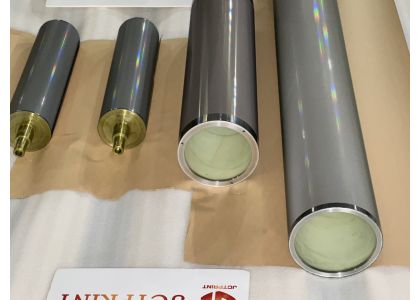Jctprint Machinery Co., Ltd

In flexographic printing, the anilox roller plays a crucial role in controlling how much ink reaches the printing plate — and ultimately, the substrate.
Among all technical parameters of an anilox roller, cell volume (measured in cm³/m²) is one of the most important factors that determine ink transfer, color strength, and print quality consistency.
This article explains how anilox cell volume influences printing results and how to choose the correct specification for your production needs.
The cell volume of an anilox roller refers to the amount of ink that each engraved cell can hold and release during printing.
It is usually expressed in cubic centimeters per square meter (cm³/m²) and depends on the engraving geometry, cell depth, and cell opening size.
In short:
Higher cell volume = more ink transfer
Lower cell volume = thinner ink film, sharper details
For example:
A 10 cm³/m² roller might be suitable for white or heavy coatings.
A 3–4 cm³/m² roller would fit fine text or halftone graphics.
Higher cell volume means the roller carries more ink, resulting in stronger color density.
However, excessive ink transfer can cause dot gain, smudging, or uneven density.
On the other hand, if the cell volume is too low, the print may look faded or under-inked, especially on absorbent substrates.
A smaller cell volume (and higher line screen) helps maintain fine image details.
This is why flexo anilox rollers used for labels or high-definition packaging often use volumes around 2–3 cm³/m² with 800–1200 LPI.
Different inks interact differently with cell volume:
UV inks require shallower cells due to high viscosity.
Water-based inks work better with medium-depth cells for stable flow.
Solvent inks can use deeper cells without overflow.
Choosing the wrong cell volume may lead to inconsistent color, poor release, or drying issues.
Selecting the right cell volume depends on multiple factors:
Printing type (line, process, solid, coating)
Ink system (UV, water-based, solvent-based)
Substrate (film, paper, foil, corrugated board)
Press speed and anilox-to-plate pressure
Here’s a general guideline:
| Printing Application | Typical Line Count (LPI) | Recommended Cell Volume (cm³/m²) |
|---|---|---|
| Coating / Varnish | 200–400 | 8–12 |
| Solid Printing | 400–600 | 5–8 |
| Process / Halftone Printing | 600–1000 | 2–4 |
| High-Definition Label Printing | 1000–1200 | 1.5–2.5 |
At JCTPRINT, we manufacture ceramic anilox rollers and sleeves engineered for optimal ink transfer and durability.
Using Oerlikon Metco ceramic coating and ALE laser engraving technology, our rollers deliver:
Stable and uniform cell structure
Consistent ink release
Excellent wear resistance and cleaning performance
Customizable line count and cell volume for every press type
Whether you need an anilox for flexo printing, coating, or corrugated applications, JCTPRINT provides tailored solutions to match your ink and substrate.
The cell volume of an anilox roller is a key variable in achieving the right ink density, color balance, and print sharpness.
Understanding this relationship helps printers minimize waste, reduce downtime, and produce consistent results.
Choose your anilox roller wisely — and rely on precision engineering to make every print count.
To learn more or request a technical recommendation, contact JCTPRINT today.
Email: [email protected]
Website: www.jctprinting.com